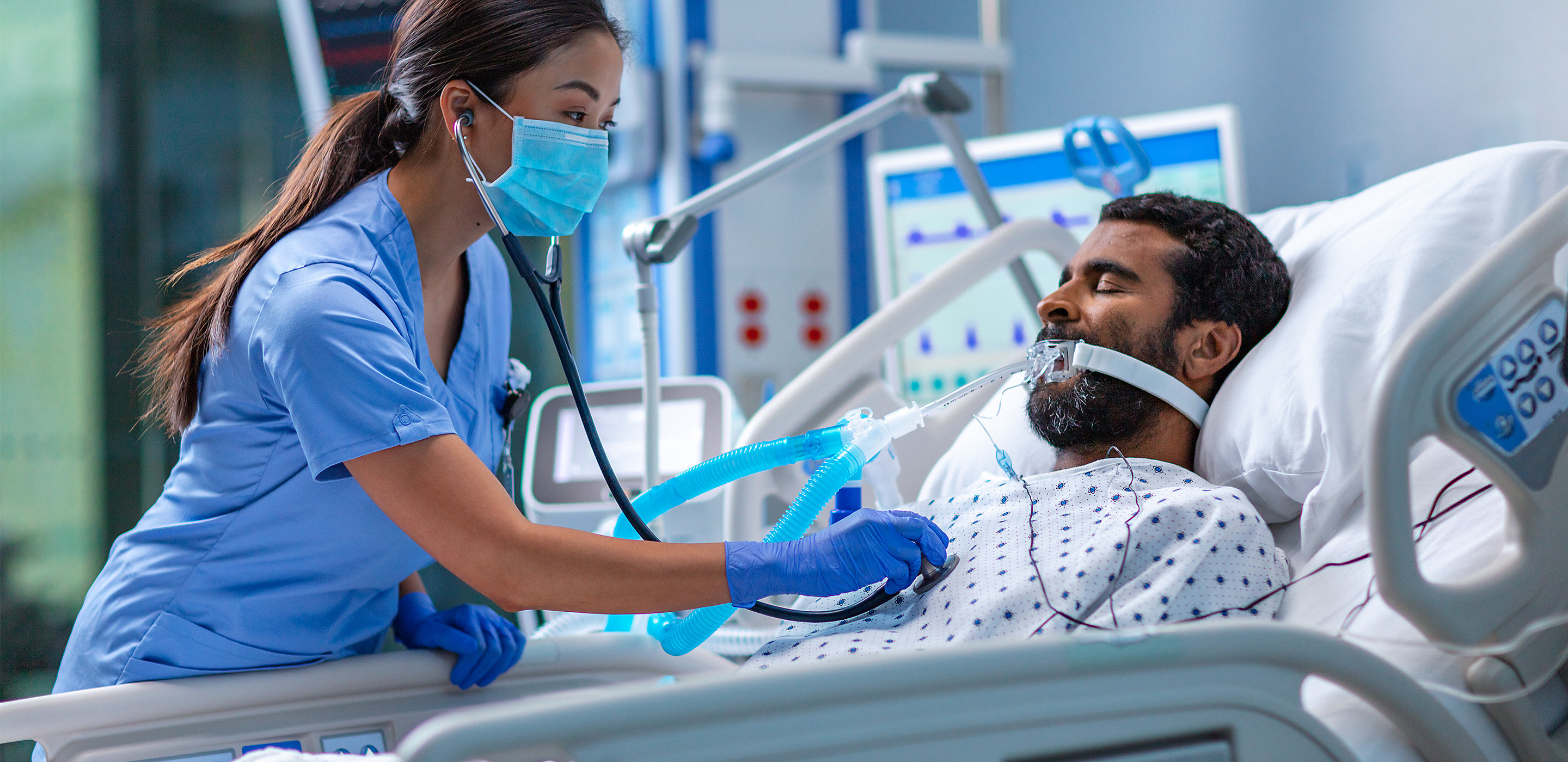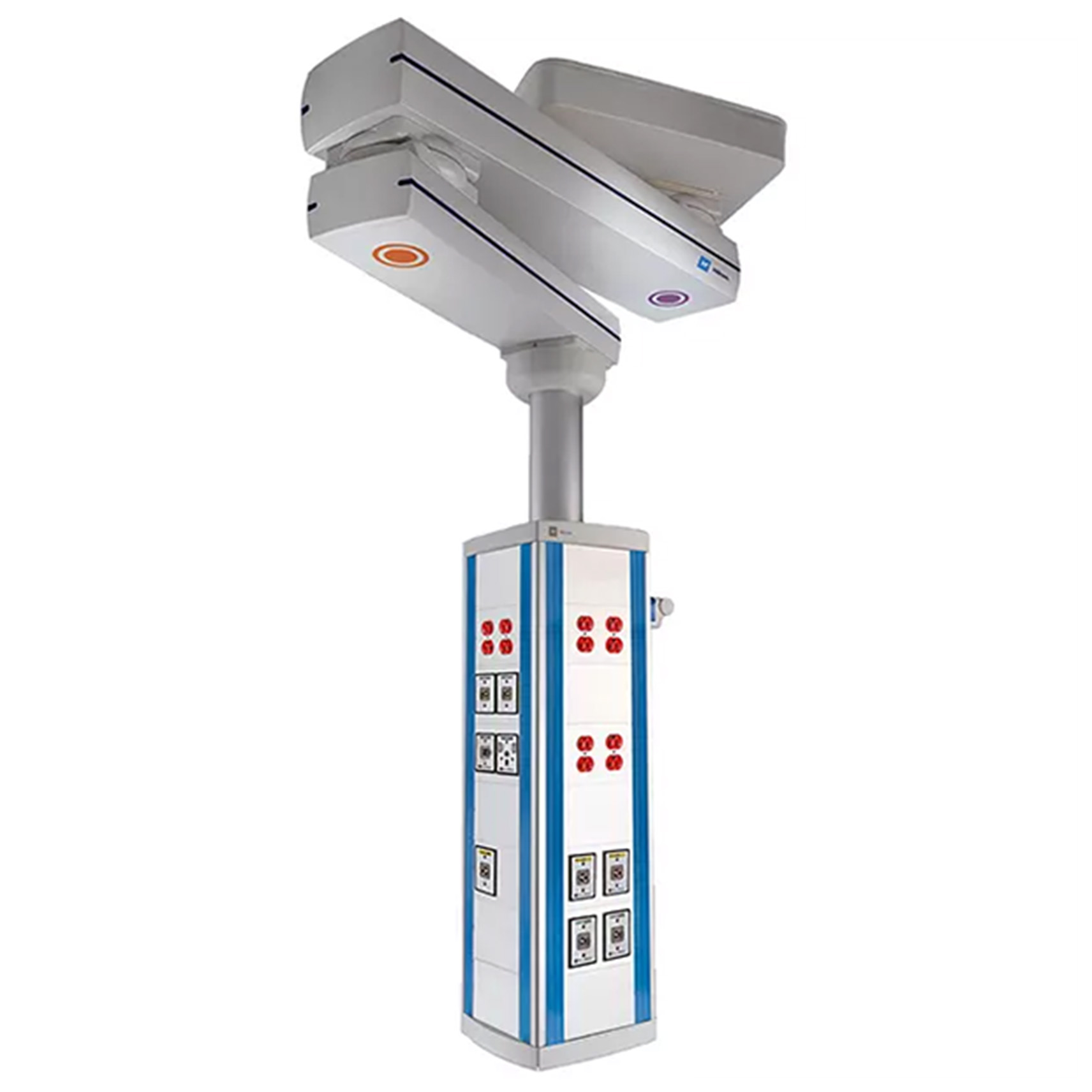Serving the Intensive Care Unit
At the Intersection of Recovery and Results
The Intensive Care Unit (ICU) moves fast. It takes actionable insights, timely interventions and a strong focus on efficiency to help these critical patients stabilize and recover as quickly as possible. We believe greater outcomes start with greater connections, so we design our solutions for the ICU to deliver exactly that — and, ultimately, to help you save and sustain lives.
You’re Committed to Caring for Your Patients.
We're Committed to Caring for You.
Staffing shortages. High-acuity patients. Rising patient-to-nurse ratios. ICU clinicians are at the forefront of today’s challenging healthcare conditions. We see you — and we’re here to support you every step of the way.
How do we do it? By focusing our innovations on practical solutions to help:
- Reduce the burden on nurses and other ICU care team members
- Improve workflow efficiency so you can keep your focus where it counts
- Protect staff safety — especially in high-pressure settings like the ICU
Read on to explore all the ways we’re supporting the ICU. Then reach out to discuss how we can do it for you.
Reduce ICU Staff Burden
The ICU is a challenging environment — and we are here to support the clinicians at the heart of it. When care teams can center their focus and activities around patient care, rather than administrative tasks and endless distractions, the possibilities for saving and sustaining lives are endless.
Reduce Alarm Fatigue
Is alarm overload affecting your team? Cut through the noise and elevate what’s urgent to help your clinicians focus on patient care. With our Voalte Alert & Alarm Management solution, you can:

Collect
and consolidate alert & alarm activity for near-real-time analysis
Filter
with customizable rules to determine which patient alarms are clinically relevant
Notify
care teams of actionable medical alarms and events in an easy-to-use mobile app
Access
waveforms, vitals and trends at your fingertips through Voalte Patient Data Visualization applications
Help reduce alarm fatigue and help your clinicians spend their time on what they love — caring for patients.
Optimize Workflows
In the ICU, your physicians, nurses and staff need to flex and shift on a moment’s notice — and they need equipment that can help them do it. We design our ICU solutions to support the unique needs of your most critical patients — and the hard-working clinicians caring for them.

Smart Beds
including built-in features to help patients breathe easier, protect their skin and get them up and moving sooner
Equipment Booms
with interchangeable modules and accessories you can attach to all four sides
Lights
that are easy to move and position where you need them
For peak performance in these high-acuity care settings, count on flexible equipment that goes where you need it.
Improve Staff Safety with Real-Time Precision Locating
Violence against clinicians has long been a pressing concern for the healthcare industry – with violence in healthcare about four times more prevalent than in any other industry.1 The right technologies can help support a safer environment.

Duress Buttons
Alert the right response teams to unsafe scenarios at the touch of a button
Real-Time Staff Locating
Further improve safety by tracking staff locations for quicker responses to duress alerts
Count on precise locating and easy-to-use duress alarms to help you protect your teams.
Protect Clinicians with Safe Patient Handling
We believe safety and mobility should go hand in hand — and that applies to clinicians as well as patients. Our safe patient handling solutions can help you safely mobilize patients without risking injury or requiring more clinicians than necessary. Our safe patient handling solutions include:

Overhead Lifts
Always at hand to help you mobilize patients safely and easily
Mobile Lifts
To bring safe patient handling support wherever you need it
Slings and Accessories
To best support each unique patient and environment
Protect your clinicians while they protect your patients. Our safe patient handling solutions can help.
Therapeutic Patient Support
We know you don’t breathe easier until your patients do. Count on our timely, clinically proven respiratory therapies to help avoid complications, keep airways clear and improve patient outcomes in your ICU.
Reduce Pulmonary Complications
When patients have pulmonary complications, it typically means more time spent in the ICU and added costs for hospitals. Oscillation & lung expansion (OLE) therapy has been proven to address this challenge in many ways, including:

31%
Overall relative reduction in postoperative pulmonary complications2
2 Day
Reduction in ICU LOS2
64%
Reduction in time on a ventilator2
With the right therapies, you can avoid these costly complications and keep your patients moving toward recovery. Help reduce pulmonary complications and get your ICU patients off ventilators and breathing on their own with respiratory therapy.
Diversify Your Therapies
The ever-changing critical care area calls for comprehensive airway clearance strategies. When our customers combine both oscillation & lung expansion (OLE) therapy and high-frequency chest wall oscillation (HFCWO) into one comprehensive airway clearance protocol, they have seen results across the hospital with multiple patient types.

3.4 day
Hospital LOS reduction with bronchopulmonary hygiene protocol with pneumonia patients3,4
1 day
ICU LOS reduction with volume expansion protocol with trauma patients5
1.12 day
Reduction in average time on the ventilator with CTICU protocol with post-surgical cardiac patients6
With more options for respiratory therapy, you can expand your respiratory therapists’ possibilities for critical decision-making and care planning.
Support Early Mobility
Immobility in the ICU is associated with muscular atrophy, delirium, pulmonary issues, skin breakdown, bacterial infections and depressive moods.7 Early mobility programs have been shown to be safe, feasible and effective for ICU patients. In fact, a study conducted at the Cleveland Clinic with 637 neurology ICU patients found that a progressive mobility program (featuring in-bed pulmonary therapy) led to:


Reduction in LOS8

Reduction in overall hospital LOS8

Reduction in ventilator days8

Reduction in overall hospital LOS8
Help your ICU patients get moving earlier and often with critical care equipment designed for safe early mobility and better patient outcomes.
Featured Solutions:

Reduce Pressure Injuries
When you’re helping patients recover, the last thing you need is a pressure injury working against them. Yet hospital-acquired pressure injuries (HAPIs) are a growing concern in intensive care and beyond:

2.5M Patients
Develop HAPIs annually, representing 8.3% of hospital admissions9,10
$3.3B - $11B
Estimated annual cost of care from pressure injuries9,10
To help reduce pressure injuries and help improve clinical outcomes, rethink your equipment. The right ICU beds and surfaces can help.
Explore All the Ways We Support Patient Recovery in the Intensive Care Unit

Smart Beds & Surfaces
Elevate your patient care with smart bed technology from Centrella, Progressa, Envella and more. Using smart hospital beds in your facility can enable patient recovery, improve caregiver response time and heighten patient safety.

Patient Monitoring
Whether you a monitoring patients remotely or at the bedside, you'll find the necessary patient monitoring devices and equipment here. Explore continuous monitoring, remote patient monitoring and vital signs monitoring solutions that you can implement in your hospital today.

Care Communications
Empower your hospital staff with connected clinical care communications solutions from Hillrom. Easily communicate across hospital roles along with patients and their families using Voalte Platform solutions. For caregivers, connect your Nurse Call systems, Alert & Alarm management, and smart beds all within one convenient platform. For IT staff, the Hillrom RTLS solution is second to none when it comes to troubleshooting hospital beds and managing your critical care devices.

Safe Patient Handling & Mobility
Utilize patient lifts such sit to stand and overhead lifts to safely transition your patients into their new position with ease. Versatile hospital transport stretchers can make all the difference when transporting trauma and surgical patients to their new destination. Find everything you need for patient mobility here.

Non-Invasive Respiratory Therapy
We’re innovating to help patients breathe easier wherever they are—by mobilizing secretions, simplifying ventilation and addressing other pulmonary issues.

Diagnostic Cardiology
Experience simple, secure and connected workflows with accurate solutions that help you reduce complexity and shorten the path to diagnosis.

Physical Exam & Diagnostics
Rely on our Welch Allyn® diagnostic solutions to help you shorten the path from detection to diagnosis and treatment and improve your productivity—with patient outcomes in mind.

Healthcare Furniture
Providing the right healthcare furniture in your hospital can create a memorable experience for your visitors and patients. Explore options from overbed tables to sleeper sofas and recliners that provide convenience and elevate experience in the hospital room.
Trending Topics
Dive into some of our latest educational resources.

A Tale of Two ICUs
Learn how remote service can simplify hospital bed repair and maintenance.

Reduce ICU Length of Stay Through Patient Mobilization
Explore strategies for prioritizing early mobility in the face of common ICU challenges — and the many benefits of doing so.

eBook: Overcoming Challenges in the ICU
Find practical guidance to help you get your most critical patients back on their feet with the Progressa Smart Bed.


Don’t Miss an Insight
Explore the latest research to help you transform care across your organization.
References:
- https://www.osha.gov/sites/default/files/OSHA3826.pdf
- Huynh TT, Liesching TN, Cereda M, Lei Y, Frazer MJ, Nahouraii MR, Diette GB, Efficacy of Oscillation and Lung Expansion in Reducing Postoperative Pulmonary Complication, Journal of the American College of Surgeons (2019).
- Grasley T. The MetaNeb® System in an acute care hospital setting: an assessment of impact on hospital length of stay using a failure mode and effects analysis. Hill-Rom White Paper. 2012.
- CDC/NCHS National Hospital Discharge Survey, 2010.
- Nyland B, Spilman S, Halub M, et al. A preventative respiratory protocol to identify trauma subjects at risk for respiratory compromise on a general inpatient ward. Respiratory Care. 2016. doi:10.4187/respcare.04729.
- Jaye D. Presented at NTI. 2016.
- Krupp A, Ehlenbach W, King B. Factors nurses in the intensive care unit consider when making decisions about patient mobility. Am J Crit Care. 2015;24(800):474-479.
- Klein KE, Bena JF, Albert NM. (2015). Impact of early mobilization on mechanical ventilation and cost in neurological ICU. Am J Respir Crit Care Med, 191:A2293.
- Padula, WV, and BA Delarmente. “The National Cost of Hospital-Acquired Pressure Injuries in the United States.” Int Wound J, 2019, pp. 1-7.
- Alderden, J, et al. “Outcomes Associated With Stage 1 Pressure Injuries: A Retrospective Cohort Study.” Am J Crit Care, vol. 27, no. 6, Nov. 2018, pp. 471-476.. 2012;366(18):1716-23.. 2012;366(18):1716-23.

















